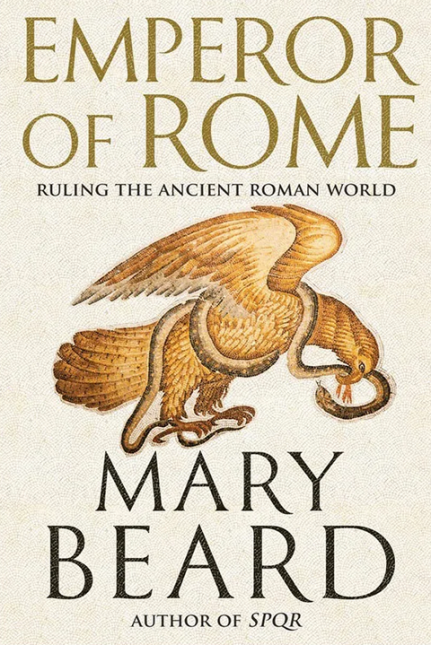Emperor of Rome: Ruling the Ancient Roman World
- By Mary Beard
- Liveright
- 512 pp.
- Reviewed by Bob Duffy
- November 29, 2023
It’s lonely (and occasionally perverted) at the top.

In Emperor of Rome, celebrated classicist Mary Beard sets us straight on the autocrats who ran the show in the imperial city. Forget those Technicolor epics from the 1950s and 60s. The emperor’s job rarely called for scooting off a batch of Christians to the Colosseum or staging caged-captive roll-abouts through town.
Beard’s Emperor is a sweeping survey of dictatorial practices and predilections in the two centuries following the assassination of Julius Caesar. Think of it as an antidote for tired pop-media accounts of hijinks on the (Capitoline) Hill. And you can count on Beard to trump the movies with fresh takes on a cast of characters often humorous, often shocking, often repulsive.
Drawing on contemporary accounts that can claim at least a scintilla of plausible veracity, Beard spotlights the routine, the quirky, and, yes, the murderous habits of rulers from Augustus through Alexander Severus. There were just 20 of these emperors, not counting the unlucky seven doomed upstarts who briefly grasped at power during two short periods of civil war.
But Emperor of Rome is no standard-issue chronological history. It’s a topical overview — and a terrifically entertaining one at that — with Beard selectively zooming in on the lives of her autocrats as they conduct the affairs of state, receive or wave off favor-seekers, and fete their subjects with banquets and arena shows. Surprisingly often, they take the imperial juggernaut on the road, with bulging entourages numbering in the high hundreds. The intent of these road trips: to show the flag in distant provinces, put down regional uprisings, or unwind on long vacations.
The destinations on these jaunts could range from North Africa to the Middle East or to Greece, Germania, and beyond — even to the empire’s edges at the border of present-day Scotland. Trajan (r. 98-117 CE) was the most traveled of Beard’s cohort, leaving Italy on two extended forays that took up the better part of four years.
Clearly, Roman emperors got away with a lot until they didn’t. About half of Beard’s 20 died by assassination (a few rumored but most reliably reported by solid sources). But life was good for the top guys as long as it lasted. Their positions made them the richest people in the empire, able to commingle their personal fortunes — substantial in their own right — with those of the national treasury. And their prominent subjects, when they died, were required to leave their own acquired wealth to the boss.
All of Beard’s emperors offer abundant examples of sovereign excess. Take Elagabalus, a cross-dressing Syrian teenager who ruled from 218-222 CE. He apparently loved to stage grand banquets for his subjects. There were color-coded dinners, where all the offerings were of the same hue (put your imagination to work on this one), and there were meals where guests’ couches were fitted with giant whoopee cushions (Beard credits him as the inventor of these devices).
And then there were repasts where “tame lions, leopards, and bears” were released to wander among the unsuspecting, dozing diners, some of whom, it’s said, were startled to death upon awakening to the hot breath of a slavering beast in their faces. Also, Elagabalus “once reputedly showered his fellow partygoers with flower petals in such over-generous quantities that the guests were smothered and suffocated.”
Another contemporary source, Cassius Dio, reports that the same Elagabalus “asked doctors to give him female private parts by means of an incision.” We can only assume — Beard and history being silent on the procedure’s outcome — that it was unsuccessful and non-fatal, as he, too, was ultimately a victim of assassination, though not on the operating table.
Another autocrat, Commodus (r. 180-192 CE), apparently fancied himself an action hero, training and sparring with gladiators and taking on, after his fashion, a horde of bears in the arena:
“In 192 CE, just a few weeks before he was killed by his trainer in a palace coup, [Commodus] hosted fourteen days of bloody shows…in which he himself was one of the star performers…The emperor opened the murderous proceedings by killing one hundred bears. It was more a tribute to his accuracy of aim than to his bravery, for…he speared them with javelins from the safety of gangways specially constructed above the arena.”
After reading Emperor of Rome, you can amaze your friends with example after example of peculiar behaviors from the men in charge: Vespasian imposing a tax on urine, Nero treading the boards as a theatrical performer while emperor, and Caligula, armed with a real dagger, killing a gladiator equipped with a wooden one.
Still, this is much more than a cabinet of curiosities. Beard supplies a wealth of fascinating background, much of it seriously informative, on the habits and practices of rulership in an era that few non-specialists would otherwise have the occasion to discover.
Bob Duffy reviews frequently for the Independent.

